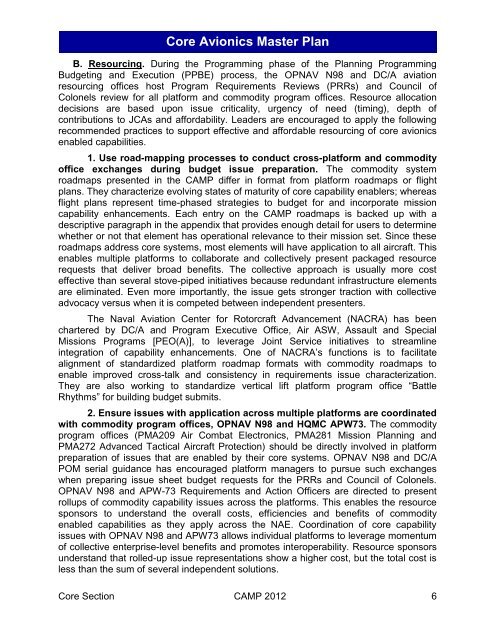PMA209 2012 Core Avionics Master Plan - NAVAIR - U.S. Navy
PMA209 2012 Core Avionics Master Plan - NAVAIR - U.S. Navy
PMA209 2012 Core Avionics Master Plan - NAVAIR - U.S. Navy
Create successful ePaper yourself
Turn your PDF publications into a flip-book with our unique Google optimized e-Paper software.
<strong>Core</strong> <strong>Avionics</strong> <strong>Master</strong> <strong>Plan</strong>B. Resourcing. During the Programming phase of the <strong>Plan</strong>ning ProgrammingBudgeting and Execution (PPBE) process, the OPNAV N98 and DC/A aviationresourcing offices host Program Requirements Reviews (PRRs) and Council ofColonels review for all platform and commodity program offices. Resource allocationdecisions are based upon issue criticality, urgency of need (timing), depth ofcontributions to JCAs and affordability. Leaders are encouraged to apply the followingrecommended practices to support effective and affordable resourcing of core avionicsenabled capabilities.1. Use road-mapping processes to conduct cross-platform and commodityoffice exchanges during budget issue preparation. The commodity systemroadmaps presented in the CAMP differ in format from platform roadmaps or flightplans. They characterize evolving states of maturity of core capability enablers; whereasflight plans represent time-phased strategies to budget for and incorporate missioncapability enhancements. Each entry on the CAMP roadmaps is backed up with adescriptive paragraph in the appendix that provides enough detail for users to determinewhether or not that element has operational relevance to their mission set. Since theseroadmaps address core systems, most elements will have application to all aircraft. Thisenables multiple platforms to collaborate and collectively present packaged resourcerequests that deliver broad benefits. The collective approach is usually more costeffective than several stove-piped initiatives because redundant infrastructure elementsare eliminated. Even more importantly, the issue gets stronger traction with collectiveadvocacy versus when it is competed between independent presenters.The Naval Aviation Center for Rotorcraft Advancement (NACRA) has beenchartered by DC/A and Program Executive Office, Air ASW, Assault and SpecialMissions Programs [PEO(A)], to leverage Joint Service initiatives to streamlineintegration of capability enhancements. One of NACRA’s functions is to facilitatealignment of standardized platform roadmap formats with commodity roadmaps toenable improved cross-talk and consistency in requirements issue characterization.They are also working to standardize vertical lift platform program office “BattleRhythms” for building budget submits.2. Ensure issues with application across multiple platforms are coordinatedwith commodity program offices, OPNAV N98 and HQMC APW73. The commodityprogram offices (<strong>PMA209</strong> Air Combat Electronics, PMA281 Mission <strong>Plan</strong>ning andPMA272 Advanced Tactical Aircraft Protection) should be directly involved in platformpreparation of issues that are enabled by their core systems. OPNAV N98 and DC/APOM serial guidance has encouraged platform managers to pursue such exchangeswhen preparing issue sheet budget requests for the PRRs and Council of Colonels.OPNAV N98 and APW-73 Requirements and Action Officers are directed to presentrollups of commodity capability issues across the platforms. This enables the resourcesponsors to understand the overall costs, efficiencies and benefits of commodityenabled capabilities as they apply across the NAE. Coordination of core capabilityissues with OPNAV N98 and APW73 allows individual platforms to leverage momentumof collective enterprise-level benefits and promotes interoperability. Resource sponsorsunderstand that rolled-up issue representations show a higher cost, but the total cost isless than the sum of several independent solutions.<strong>Core</strong> Section CAMP <strong>2012</strong> 6

















